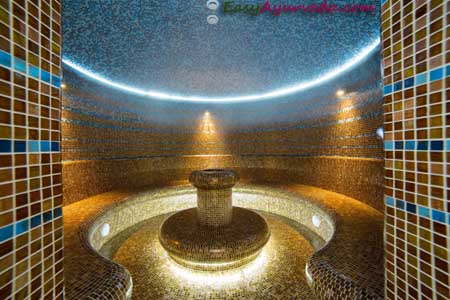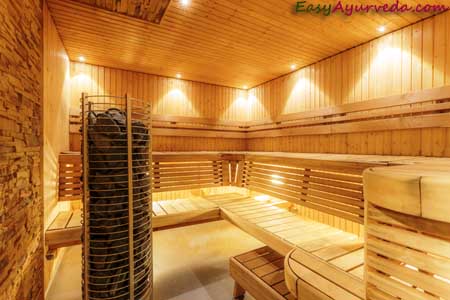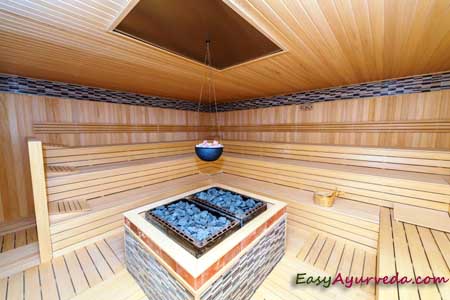Jentaka Sweda – Dry Hot Bath Method, Benefits, Precautions
Article by Dr Raghuram Y.S. MD (Ay) & Dr Manasa, B.A.M.S
Jentaka means ‘dry hot bath’. Here, the sweating therapy is given in a special constructed room called Kutagara. Kutagara means Sudatorium – circular vaulted sweating room.
Sweda means sudation, steaming, sweating, fomentation
Jentaka Sweda is a special type of sudation which is conducted in a special constructed vaulted sweating room called Kutagara.
Table of Contents
Category
Jentaka Sweda is one among the 13 types of Sa-agni Sweda. Since the medicaments are heated on burning coal or fire to produce heat so as to provide sudation, it is considered as Saagni Sweda (Saagni = involving fire).
Jentaka Sweda is also a type of Ruksha Sweda – dry sudation because fluids are not used in this treatment procedure.

Since the entire body of the patient is subjected to sweating in this procedure, it is considered under sarvanga sweda – full body sudation. Due to the same reason it can also be considered as Bashpa Sweda.
Kutagara construction
Construction of Kutagara (circular vaulted sweating chamber) –
For the construction of Kutagara an ideal place should be selected. The place where sudatorium is to be constructed and the land therein should be thoroughly examined for its suitability, it should match all the criteria needed for construction of Kutagara.
Criteria for construction of Kutagara:
The kutagara should be constructed far from the town of the patient. The kutagara should be constructed to the North or East direction of the city.
The land should be wholesome (prashasta bhumi bhaga) and praised.
The land should comprise of Krishna mrittika (black mud) or Suvarna mrittika (golden colored soil).
The kutagara should be constructed in the close vicinity of a lake or any other clean water reservoir. It should be constructed towards South or West of the water reservoir. The bank of the reservoir on which the kutagara is constructed should be plain, leveled and even.
The kutagara should be constructed at a distance of 7 – 10 aratni distance (10-12 feet) away from the water reservoir. The door of the kutagara should face North or East, i.e. it should face the water reservoir. The kutagara is constructed as a circular room.
Length of the kutagara should be 16 aratni i.e. 24 feet approximately and the height should be approximately 16 aratni i.e. 24 feet. Here since the room is circular, the length is equal to the diameter of its circle.

Kutagara should have well built strong walls, thoroughly applied and layered with mud coating. It should have small ventilator (vatayana) all around its circumference.
Pindika – Within the kutagara a pindika or platform of height 1 aratni (1.5 feet) and width 1 aratni (1.5 feet) should be constructed all along its circumference, from door to door, constructed adjacent to the wall.
Angarakoshta stambha – At the center of the interior part of the kutagara is constructed an angarakoshta stambha (a pillar shaped furnace). Angara means burning coal. Koshta means having space inside it. Stambha means pillar. Thus, angarakoshta stambha is a pillar shaped construction which has space within it to accommodate burning charcoal in it. Its shape should be like a kanduka (ball shaped) of 4 aratni dimension (6 feet) and of the height of a human being (purusha pramana). It should be made out of mud. It should have multiple small orifices all around the angarakoshta for movement of air. The upper opening should be fit with a cork. Within the chamber of the pillar (space) dry wood of Khadira (Acacia catechu), Ashvakarna (Dipterocarpus alatus) etc should be put and burnt.
When the above said wood have been burnt properly and all the smoke has been eliminated leaving back only the burning charcoal devoid of smoke, leaving the room heated up, it would be ready to send the patient in to be subjected to Jentaka Sveda.
Attendants
Paricharaka (attendants) –
In Jentak Swed the patient will be sent alone inside the kutagara to undergo sudation. But still attendants and helpers are needed for preparing the kutagara (constructing), to arrange the fuel for ankarakoshta, to see that the room is heated enough for the patient to enter, to give massage to the patient, and attend to the patient after he comes out of the room (since the patient will be tired enough due to sudation). For this 4-5 helpers are needed. It is mandatory for the physician to remain outside the kutagara and keep a check on the patient inside the treatment chamber.

Procedure
Purvakarma
Jentaka Svedana Vidhi Vidhana (Method of administration)
Abhyanga – Massage should be given with herbal oils to the patient before sending him inside the kutagara.
Counseling – The patient should be thoroughly counseled and provided with words of courage before making him enter the kutagara. He should also be detailed about the procedure he is going to undergo and it’s utility. He should be told that he is entering the kutagara for his benefit and also to get rid of the disease he is suffering from.
Advice to the patient – The patient is asked to sleep on any one side of the platform nearby the door, by covering himself with cloth. He should be told that he is supposed to stay alone in the room and the door would be closed once he enters the room. After sleeping on the pindika or platform, the patient can change postures according to his convenience and comfort. He should not be scared. He should be strictly advised not to leave the platform in spite of experiencing burning sensation, fainting etc. due to sweating. He should be courageous and keep moving along the platform and end up at the other end of the platform after moving for once full circle. Now again he will be close to the door. If he gets scared due to what he is experiencing and leaves the platform, there will be a chance that he hits the furnace in the dark and suffer from burns and other complications, he may also die. When he comes to know that he has been properly subjected to sudation, when there is reduction of abhishyanda (dampness) in his body, when he experiences proper elimination of sweat and slimy materials (sweda and pichcha) from his body, experience lightness of the body (laghuta) and destruction of heaviness (gourava), blocks and constipation (vibandha) and stambha (stiffness of the body parts), which also indicate proper signs of sudation, the patient, with the aid of (taking support of) the platform should slowly get up, open the door and gradually come out of the kutagara. He should be educated neither to touch nor sprinkle cold water to his face and eyes after coming out of the kutagara. If he does that, he would damage his vision.
Swasthi Vachana – Prayers should be offered to the God for the welfare of the patient and for the success of the treatment. The patient should also be advised to offer prayers if he is comfortable doing so.
Pradhana karma
Entry into the kutagara and administering Jentaka Sweda – The patient is covered with cloth and sent into the kutagara. The door should be closed after wishing the patient for good. The room would have been heated up by now. The patient, as instructed sleeps on one side of the platform. Slowly he moves towards the other end of the platform after finishing once full circle (moving along the platform) and reaches the door. Meanwhile the physician keeps inquiring his condition from outside. By this time he would experience proper signs of sudation. The patient opens the door and slowly comes out.
Duration of Jentaka Sweda – Jentaka Sweda shall be carried out for a period of 1 muhurta or 48 minutes or as advised by the physician. Or as a general principle of Swedana, the sudation should be done till the proper signs of sudation (samyak swinna lakshanas) have been observed.
Paschat karma
Paschat Kriya (post-swedana measures) – After exiting the kutagara, the patient should not be given cold comforts (cold foods, drinks, bath or face wash). He should be given rest for 1 muhurta time i.e. 48 minutes. Later he should be given with hot water bath. Following this he should be given light diet. Simultaneous with the swedana, the patient should be administered with disease modifying shamana aushadhas (medicines). Nitya Virevhana (daily purgation) to expel the toxins which are released into the system during swedana should be given if needed.
Indications, Benefits
Indications and Benefits of Jentaka Sweda
Jentaka Sweda can be administered in all those conditions wherein sarvanga sweda (full body sudation) can be done comprehensively and in the best possible way. Those conditions include –
- Vata rogas – diseases caused by vitiated vata
- Kapha rogas – diseases caused by vitiated kapha
- Vata-Kapha rogas – diseases caused by combined and simultaneous association of Vata and Kapha
- Sarvanga Vata – Vata vitiated in the entire body
- Mamsagata Vata – Myalgia and other neuromuscular conditions caused by vitiated vata
- Pakshaghata – paralysis, hemiplegia,
- Anga gaurava – heaviness of the body
- Angamarda – pain all over the body as if someone is hitting hard
- Adyavata – Rheumatoid arthritis, Gouty arthritis
- Vamana Yogya – to those who are to be given therapeutic emesis
- Vasti Yogya – to those who are to be given enema therapies
- Sankocha – contractures in the body
- Ama dosha – diseases caused by improperly processed food essence in circulation
- Shaitya – excessive coldness in the body
- Shotha – generalized edema
- Vepathu – tremors
- Anaha – flatulence, distension of abdomen
- Vinamika – bending of body
- Kati graham – stiffness in the waist (hips, low back)
- Kukshi graham – gripping pain or discomfort or stiffness in the abdominal (flanks) or pelvic regions
- Ardita – facial paralysis etc
Limitations
Limitations of Jentaka Sweda
The patient has to stay alone in the kutagara while undergoing Jentaka Sweda. A lot of counseling towards the patient is needed, many instructions need to be given and the patient needs to follow the instructions. Therefore this form of swedana may be preferred to only those patients who are wise enough, intelligent to follow the instructions, not over-enthusiastic to experiment things in the absence of physicians or attendants in the kutagara, and cooperative.
Jentaka Sweda needs a separate set-up under strict rules and regulations as given in Ayurvedic treatises. All hospitals and clinics cannot provide this facility. Even the hospitals which are isolated from the cities find it difficult to manage this type of swedana. We hardly find many doctors practicing Jentaka Sweda in their clinical practice.
There are other forms of Swedana which may give similar impact if not the same. They also can be practiced easily. Therefore the Jentaka is not preferred many times.
Those suffering from mental conditions, unmade (insanity, lunacy), apasmara (epilepsy, memory disorders), depression, bipolar disorders etc cannot be given with Jentaka Sweda because they cannot follow the instructions properly.
People suffering from crippling diseases like paralysis, rheumatoid arthritis etc, need constant supervision during any treatment. They cannot be sent all alone in the kutagara because if they find difficult to tolerate the swedana it is not possible for them to move around or seek help. They also cannot move freely over the platform.
Children and old aged people cannot be managed in the kutagara.
This treatment can be done only to those who are physically and mentally fit.
Advantages
Advantages of Jentaka Sweda
Jentaka Sweda provides the best sudation for whole body and is the most praised one.
Sweating therapy can be given to more than 1 person at a time in the Kutagara. They will experience signs of proper sudation (swinna lakshanas) at different times and will exit at different times).
Jentaka Sweda is a treatment for many disorders and one among the best of all the swedana treatments. It is the best one for those who are courageous of undergoing the treatment and intelligent enough to follow the instructions apart from being physically and mentally fit.
Click to Consult Dr Raghuram Y.S. MD (Ayu) – Email / Skype







